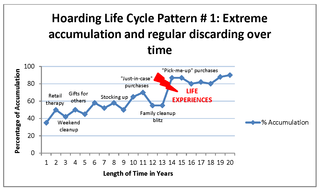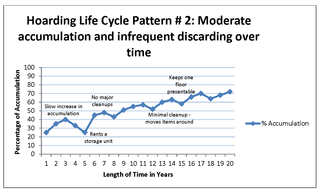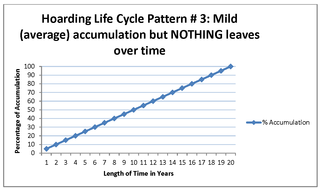Environment
The Top 3 Hoarding Life Cycle Patterns
Is it true that people who hoard can’t discard?
Posted October 14, 2019 Reviewed by Gary Drevitch
One misconception about hoarding is that people who hoard can’t discard.
Not necessarily so.
Some people who hoard can discard just fine. What they never do is balance the volume of what they acquire with what they part with. A bottleneck is created, which, given enough time, produces the hoard.
This pattern differs from person to person, affecting how much time it takes for a hoarding problem to develop over a lifetime, what I refer to as a hoarding life cycle pattern.

Hoarding Life Cycle Pattern # 1
This pattern addresses the person who can regularly decide whether to discard items but develops a hoarding problem through extreme acquiring. A hoarded environment may be brought under temporary control only to recur with the next arrival of acquisitions. There is an ebb and flow, depending on the number of accumulated items arriving and leaving at any point. Sometimes the person can find it acceptable to discard if they know the item is going to someone who can use it, appreciate it, and take good care of it.
Whether or not your environment is hoarded, the following events can put you and others at risk; any level of hoarding elevates that risk:
If an electrical or gas heat-producing appliance malfunctions, fire is a real possibility. A hoarded environment increases the fuel load and (depending on where the accumulation is located) decreases the options for a safe exit in case of emergency. Combustible items in the hoarded environment add to the speed at which the fire will spread and consume the environment and anything inside it. There is a combined risk when firefighters hose down the inside of a building, unaware that a hoarded environment exists. Responders can also be injured or perish as floors collapse under the weight of wet items.
If flooding occurs (whether your unit caused the flood or not):
- Nonabsorbent items, such as televisions and electrical appliances, will be destroyed.
- Absorbent items, such as boxes, papers, and furniture, will hold the fluid, and the accumulation of wet items will weigh far more than it did when dry.
- Depending on the volume of items, the structural integrity of floors may fail, causing them to collapse, taking possessions and occupants with them.
A destabilizing setback can upset the “checks and balance” strategy of discarding regularly. Setbacks in life are inevitable. They happen to all of us. Will the crisis require increased “retail therapy” to provide a pick-me-up? Old habits die hard. It won’t take long to become overwhelmed again.
Hoarding Life Cycle Pattern #2
This pattern offsets infrequent discarding by acquiring fewer things less frequently over time. This pattern takes longer to develop into a hoarded environment, but it has the same potential to lead to an extreme hoarding situation.
This pattern of accumulation involves acquiring, rigid saving, and the possibility of using. People want to get value from each item, so they ask themselves, “How much did I spend on it?” If they feel that they haven’t gotten enough use or value from the item, they may not be willing to let it go yet. They mistakenly believe that by holding onto the item, they somehow retain the money they spent on it or its ideal value, even if the item proves not to be as useful as anticipated. Keeping items, even if they are rarely if ever used, feels like a way to get their money’s worth.

Discarding happens differently as well. They tell themselves that they are too busy to spend the time it takes to discard, and they may have genuinely busy lives. They tell themselves that they will do it later and put things down “just for now.” They tend to overcommit their time and energy and are chronically overscheduled.
People who accumulate and fail to resolve the clutter buildup need to reflect on why they keep themselves so busy. How necessary is that super busy schedule really? As the buildup happens, no matter the reasons, they are vulnerable to the same risks that hoarders face — fire, flood, and increased piles/pathways when coping with life’s inevitable setbacks.
Hoarding Life Cycle Pattern #3
This pattern involves accumulating not much more than the average person accumulates, but never discarding anything. Not one thing that enters the environment ever leaves it. Perhaps the person has an elaborate recycling system, but the items never actually make it out to the recycling bin. Perhaps the person is saving and storing items for others, such as items for a younger sibling’s children, even though the sibling doesn’t have a partner yet and does not expect to have children in the foreseeable future, if ever. This pattern offers a “noble” way to keep everything. The situation may take a while to develop into an extreme hoarding environment, but given enough time, if nothing intervenes, extreme hoarding will occur. Consider adopting the approach of “Just do it now." It never gets easier to deal with accumulation.

If you see yourself or someone close to you anywhere on this continuum, please reach out for hoarding-informed help sooner rather than later (even if you have to access it through available remote or online technologies).




